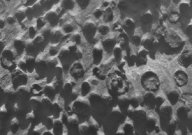Space & Astronomy
September 16, 2012 · 18 comments
18 comments

Image Credit: NASA
"This is one of the most extraordinary pictures from the whole mission," said principal investigator Steve Squyres. "Kirkwood is chock full of a dense accumulation of these small spherical objects. Of course, we immediately thought of the blueberries, but this is something different. We never have seen such a dense accumulation of spherules in a rock outcrop on Mars."[!gad]Curiosity might have been hitting the headlines lately but on a different part of the Red Planet its fellow rover Opportunity is still going strong. The latest images returned show a dense concentration of strange spherical shapes on the Martian surface. The spheres are similar to those found by Opportunity in 2004 ( nicknamed 'blueberries' ) but there are stark differences.
"This is one of the most extraordinary pictures from the whole mission," said principal investigator Steve Squyres. "Kirkwood is chock full of a dense accumulation of these small spherical objects. Of course, we immediately thought of the blueberries, but this is something different. We never have seen such a dense accumulation of spherules in a rock outcrop on Mars."
Source: NASA | Comments (18)
Mystery spheres photographed on Mars
By T.K. RandallSeptember 16, 2012 ·
 18 comments
18 comments
Image Credit: NASA
The Opportunity rover has snapped a picture of strange spherules that has experts scratching their heads.
Curiosity might have been hitting the headlines lately but on a different part of the Red Planet its fellow rover Opportunity is still going strong. The latest images returned show a dense concentration of strange spherical shapes on the Martian surface. The spheres are similar to those found by Opportunity in 2004 ( nicknamed 'blueberries' ) but there are stark differences."This is one of the most extraordinary pictures from the whole mission," said principal investigator Steve Squyres. "Kirkwood is chock full of a dense accumulation of these small spherical objects. Of course, we immediately thought of the blueberries, but this is something different. We never have seen such a dense accumulation of spherules in a rock outcrop on Mars."[!gad]Curiosity might have been hitting the headlines lately but on a different part of the Red Planet its fellow rover Opportunity is still going strong. The latest images returned show a dense concentration of strange spherical shapes on the Martian surface. The spheres are similar to those found by Opportunity in 2004 ( nicknamed 'blueberries' ) but there are stark differences.
"This is one of the most extraordinary pictures from the whole mission," said principal investigator Steve Squyres. "Kirkwood is chock full of a dense accumulation of these small spherical objects. Of course, we immediately thought of the blueberries, but this is something different. We never have seen such a dense accumulation of spherules in a rock outcrop on Mars."
NASA's long-lived rover Opportunity has returned an image of the Martian surface that is puzzling researchers.
Source: NASA | Comments (18)

The Unexplained Mysteries
Book of Weird News
AVAILABLE NOW
Take a walk on the weird side with this compilation of some of the weirdest stories ever to grace the pages of a newspaper.
Click here to learn more

Support us on Patreon
BONUS CONTENTFor less than the cost of a cup of coffee, you can gain access to a wide range of exclusive perks including our popular 'Lost Ghost Stories' series.
Click here to learn more
Ancient Mysteries and Alternative History
United States and the Americas
Israel, Palestine and the Middle-East
Earth, Natural Disasters and the Environment
Total Posts: 7,768,495 Topics: 325,026 Members: 203,771
Not a member yet ? Click here to join - registration is free and only takes a moment!
Not a member yet ? Click here to join - registration is free and only takes a moment!



























Please Login or Register to post a comment.